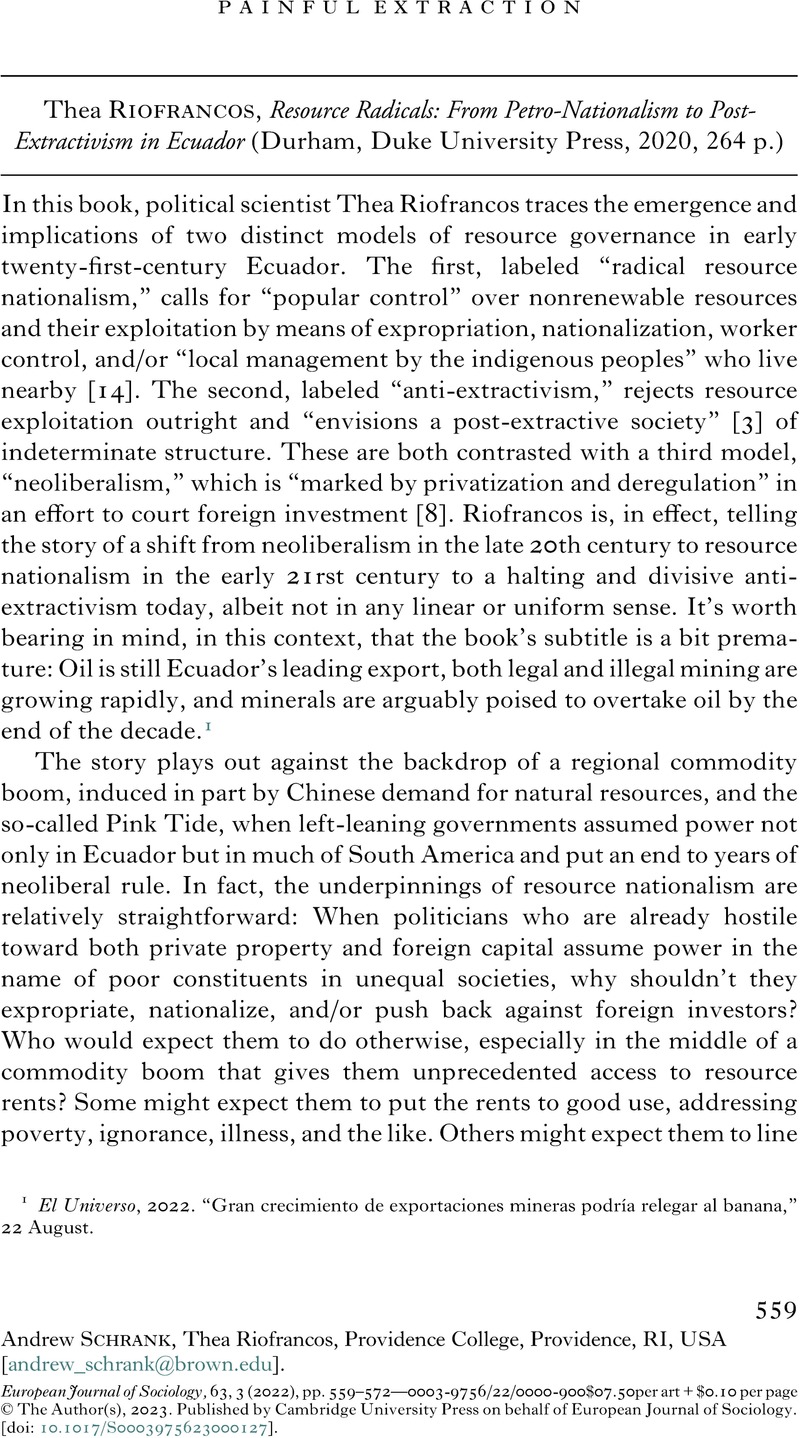No CrossRef data available.
Published online by Cambridge University Press: 13 March 2023

1 El Universo, 2022. “Gran crecimiento de exportaciones mineras podría relegar al banana,” 22 August.
2 See also Catherine Conaghan, 2016. “Ecuador Under Correa,” Journal of Democracy, 27 (3): 109–118 ; Omar Sanchez-Sibony, 2018. “Competitive Authoritarianism in Ecuador under Correa,” Taiwan Journal of Democracy, 14 (2): 97–120.
3 Page 37, in M. Victoria Murillo, 2009. Political Competition, Partisanship, and Policy Making in Latin American Public Utilities (Cambridge, Cambridge University Press).
4 Source : the AmericasBarometer by the LAPOP Lab [www.vanderbilt.edu/lapop, accessed September 7, 2022]. Others offer similar estimates of the size of the indigenous population [page 139 in Pan American Health Organization, 2017. Health in the Americas: Summary Regional Outlook and Country Profiles (Washington, PAHO); page 392 in International Work Group for Indigenous Affairs, 2022. The Indigenous World 2022 (Copenhagen, IWGIA); however, Jeffery Paige presents the much higher figure of “20–25%” for the “insurrectionary period” at the turn of the 20th century : page 25 in Jeffery Paige, 2020. Indigenous Revolution in Ecuador and Bolivia, 1990–2005 (Tucson, University of Arizona Press).
5 Andrés Bermúdez Liévano, 2019. “En Ecuador, pelea por mina se convierte en disputa por la identidad indígena,” Diálogo Chino, 1 July.
6 Page 54, in Paige 2020, cf. infra.
7 Bermúdez Liévano 2019, cf. infra; Andrés Bermúdez Liévano, 2021. “El ambientalista Yaku Pérez sorprende en laselecciones de Ecuador,” 10 February [ https://dialogochino.net/es/comercio-y-inversiones-es/39773-yaku-perez-la-sorpresa-electoral-en-las-elecciones-de-ecuador/].
8 Page 15, in Jeffery Paige 2020.
9 One might also ask why the identity of mestizaje doesn’t receive more attention, whether actors whose ethnic identities aren’t specified are presumed to be mestizo, and why.
10 Kenneth Gould, 2004. “Interrogating the Treadmill of Production: Everything You Wanted to Know About the Treadmill but Were Afraid to Ask,” Organization and Environment, 17 (3): 296–316.
11 Paige 2020: 287.
12 Freedom House, 2022. Freedom in the World 2022: The Global Expansion of Authoritarian Rule (Washington, Freedom House).
13 David Adler and Guillaume Long, 2021. “We need a new observatory of democracy in the Americas,” Guardian, Nov. 15. José Ignacio Araya, 2022. “Ministro de Defensa de Ecuador advierte que la democracia ‘está en riesgo’ tras más de una semana de protestas,” La Tercera, 22 junio; Alexandra Valencia, 2022a. “Ecuador declares force majeure for oil, state of exception over protests,” Reuters, June 18.
14 Page 57, in Ronald Inglehart, 1995, “Public Support for Environmental Protection: Objective Problems and Subjective Values in 43 Societies,” PS: Political Science and Politics, 28 (1): 57–72.
15 Frederick Weil, 1987. “Cohorts, Regimes, and the Legitimation of Democracy: West Germany Since 1945,” American Sociological Review, 52 (3): 308–324; Howard Sanborn and Clayton Thyne, 2014. “Learning Democracy: Education and the Fall of Authoritarian Regimes,” British Journal of Political Science, 44 (4): 773–797. Inglehart 1995, cf. infra; Axel Franzen and Reto Meyer, 2010. “Environmental Attitudes in Cross-National Perspective: A Multilevel Analysis of the ISSP 1993 and 2000,” European Sociological Review, 26 (2): 219–234; Raphael Nawrotzki and Fred C. Pampel, 2013. “Cohort change and the diffusion of environmental concern: a cross-national analysis,” Population & Environment, 35 (1): 1–25.
16 The bivariate associations are linear and consistent with a multivariate analysis available from the author. In the rest of Latin America, the gap between primary completers (62.4) and college graduates (39.9) is less stark (i.e., 22.5 points as opposed to 28.3 points), albeit in the same direction.
17 See Alwin and McCammon 2003 on the differences between age, cohort, and generation: Duane Alwin and Ryan McCammon, 2003. “Generations, Cohorts, and Social Change,” Ch. 2 in Jeylan T. Mortimer and Michael J. Shanahan, eds, Handbook of the Life Course (New York, Kluwer Academic).
18 Paige 2020: 303.
19 See, e.g.: 70, 114.
20 Paige 2020: xiv.
21 Paige 2020: 43.
22 Paige 2020: 44–45. There are important parallels in the debate over minority boarding schools (neidiban) in contemporary China. In fact, James Leibold holds that “most ethnographic studies on neidiban schools demonstrate how extended periods of dislocation actually heighten the sense of otherness among graduates,” and wonders whether the long-term results could include social and political instability [Page 9–10, in James Leibold, 2019. “Interior Ethnic Minority Boarding Schools: China’s Bold and Unpredictable Educational Experiment,” Asian Studies Review, 4 (1): 3–15].
23 See Charles Kurzman and Lynn Owens, 2002. “The Sociology of Intellectuals,” Annual Review of Sociology, 28: 63–90.
24 Paige is quite self-conscious about this, noting that he takes “matters of population definition and selection seriously” in his entirely qualitative study of a small sample of respondents due to his training in “mid-twentieth-century quantitative social science” [302].
25 Page 149; see also page 5, in Rachel Sieder and Anna Barrera Vivero, 2017. “Legalizing Indigenous Self-Determination: Autonomy and Buen Vivir in Latin America,” The Journal of Latin American and Caribbean Anthropology, 22 (1): 9–26. Jason Brennan, 2017. Against Democracy (Princeton, Princeton University Press); Fernando Mires, 2021. “La imposibilidad democrática,” TalCual, 18 April.
26 Benjamin Goldfrank and Andrew Schrank, 2009. “Municipal Neoliberalism and Municipal Socialism: Urban Political Economy in Latin America,” International Journal of Urban and Regional Research, 33 (2): 443-462; Kent Eaton, 2017. Territory and Ideology in Latin America: Policy Conflicts between National and Subnational Governments (Oxford, Oxford University Press).
27 Bermúdez Liévano 2021.
28 Goldfrank and Schrank 2009: 457, cf. infra.
29 Some have raised the specter of gender discrimination [see, e.g., Racliffe et al. 2004, esp.: 404–405; Sieder and Barrera 2017 : 7], an issue which receives almost no attention from Riofrancos.
30 Mark Wexler, 1996. “A Sociological Framing of the NIMBY (Not-In-My-Backyard) Syndrome,” International Review of Modern Sociology, 26 (1): 91–110.
31 Page 44, in World Bank, 2021. Creating Markets in Ecuador: Fostering a Dynamic and Resilient Private Sector (Washington, World Bank).
32 Ana Belén Rosero, 2022. “La prohibición de salida del Ecuador de Leonidas Iza se activa nuevamente,” El Comercio, Sept. 1; Alexandra Valencia, 2022b. “Negotiations with indigenous groups test Ecuador’s government,” Reuters, Sept. 7.